
In public speaking, two prominent types of speeches stand out: informative speeches and persuasive speeches. While both serve as vehicles for communication, they diverge in their objectives, content, delivery, and desired outcomes. This paper will examine the differences between informative and persuasive speeches, highlighting their distinct characteristics and exploring the implications of these differences on both speakers and audiences.
Understanding Informative Speech
An informative speech is primarily aimed at imparting knowledge, educating the audience, or providing insights into a particular topic or subject matter. The overarching goal of an informative speech is to enhance the audience’s understanding and awareness of the chosen topic. Unlike persuasive speeches, which seek to sway opinions or prompt action, informative speeches focus on delivering factual information in a clear, objective manner.
Characteristics of Informative Speeches:
- Objective Tone: Informative speeches maintain an objective tone devoid of personal bias or persuasive language. The speaker aims to present information impartially, allowing the audience to form their own opinions based on the facts presented.
- Factual Content: The content of informative speeches is grounded in verifiable facts, data, evidence, or expert opinions. Speakers often rely on credible sources to support their assertions and ensure the accuracy and reliability of the information conveyed.
- Educational Focus: Informative speeches prioritize education and enlightenment, providing the audience with new knowledge or insights into a topic. The speaker may employ various techniques such as explanation, demonstration, or illustration to facilitate understanding.
- No Call to Action: Unlike persuasive speeches, informative speeches do not include a call to action or an explicit attempt to influence the audience’s behavior or beliefs. The focus is on disseminating information rather than eliciting a specific response from the audience.
Example of an Informative Speech Topic:
Topic: The Impact of Climate Change on Global Biodiversity Thesis Statement: “In this informative speech, I will explore the effects of climate change on global biodiversity, examining the scientific evidence, ecological implications, and potential solutions to mitigate its adverse effects.”
Persuasive Speech

In contrast to informative speeches, persuasive speeches are designed to persuade, influence, or motivate the audience to adopt a particular viewpoint, belief, or course of action. Persuasive speeches employ rhetorical strategies, emotional appeals, and persuasive language to sway the audience’s opinions, attitudes, or behaviors. The ultimate goal is to prompt the audience to accept the speaker’s argument and take action accordingly.
Characteristics of Persuasive Speeches:
- Persuasive Language: Persuasive speeches utilize language that is emotive, persuasive, and compelling. The speaker may employ rhetorical devices, anecdotes, testimonials, or appeals to emotion to persuade the audience and evoke a specific response.
- Argumentative Structure: Persuasive speeches follow an argumentative structure, presenting a clear thesis statement or proposition and supporting it with evidence, reasoning, and persuasive appeals. The speaker seeks to convince the audience of the validity and merit of their argument.
- Call to Action: Persuasive speeches often include a call to action, urging the audience to take a specific course of action or adopt a particular viewpoint. The speaker aims to motivate the audience to change their behavior, attitudes, or beliefs in alignment with the speaker’s objectives.
- Audience Engagement: Persuasive speeches prioritize audience engagement and involvement, seeking to capture the audience’s attention, elicit emotional responses, and foster a sense of urgency or importance regarding the topic.
Example of a Persuasive Speech Topic:
Topic: The Importance of Recycling in Preserving the Environment Thesis Statement: “In this persuasive speech, I will argue that recycling is essential for preserving the environment and mitigating the impacts of climate change, providing compelling evidence and practical steps for individuals to take action.”
Contrasting Objectives

One of the fundamental distinctions between informative and persuasive speeches lies in their objectives. While informative speeches seek to educate and inform the audience, persuasive speeches aim to persuade, influence, or motivate them to take a specific action or adopt a particular viewpoint. This fundamental difference in objectives shapes the content, delivery, and overall approach of each type of speech.
Informative speeches prioritize the dissemination of factual information and the enhancement of audience understanding. Speakers strive to present information objectively, relying on evidence-based research and credible sources to support their assertions. The focus is on providing the audience with new knowledge or insights into a topic, without seeking to influence their opinions or behavior.
In contrast, persuasive speeches are driven by the desire to sway the audience’s opinions, attitudes, or behaviors. Speakers employ persuasive language, emotional appeals, and rhetorical strategies to convince the audience of the validity and importance of their argument. Persuasive speeches often include a call to action, urging the audience to take specific steps or adopt a particular viewpoint in alignment with the speaker’s objectives.
Divergent Content and Structure
The content and structure of informative and persuasive speeches also diverge significantly, reflecting their respective objectives and approaches to communication. Informative speeches prioritize factual information and educational content, presenting a comprehensive overview of the topic at hand. Speakers focus on providing evidence-based research, expert opinions, and relevant data to support their assertions and enhance audience understanding.
The structure of informative speeches typically includes an introduction, body, and conclusion. The introduction provides an overview of the topic and previews the main points to be covered, while the body of the speech delves into the details, presenting factual information and supporting evidence. The conclusion summarizes the key points and reinforces the central theme of the speech.
On the other hand, persuasive speeches follow an argumentative structure, presenting a clear thesis statement or proposition and supporting it with evidence, reasoning, and persuasive appeals. The introduction establishes the speaker’s position and previews the main arguments to be presented, while the body of the speech presents compelling evidence, emotional appeals, and persuasive language to support the speaker’s viewpoint. The conclusion reinforces the central argument and includes a call to action, urging the audience to accept the speaker’s position and take specific steps in response.
Conclusion
While both informative and persuasive speeches serve as effective tools for communication, they differ significantly in their objectives, content, delivery, and desired outcomes. Informative speeches prioritize education and enlightenment, providing the audience with factual information and insights into a topic. Persuasive speeches, on the other hand, aim to persuade, influence, or motivate the audience to adopt a particular viewpoint or take specific action. By understanding the nuances of each type of speech, speakers can tailor their message to effectively engage and communicate with their audience, whether seeking to inform, persuade, or inspire.
Are you tired of grappling with challenging assignments and tight deadlines? Take a breather and let our expert writers handle the heavy lifting for you. With a proven track record of delivering top-quality academic papers, we’re here to help you succeed. Reach out to us now and experience the relief of knowing your writing tasks are in capable hands.
FAQs
What is the main difference between an informative speech and a persuasive speech?
An informative speech aims to educate, enlighten, or inform the audience about a specific topic, while a persuasive speech seeks to persuade, influence, or motivate the audience to adopt a particular viewpoint or take specific action.
What is the primary objective of an informative speech?
The primary objective of an informative speech is to provide factual information, insights, or knowledge about a topic, enhancing the audience’s understanding and awareness without seeking to persuade or influence their opinions.
What is the primary objective of a persuasive speech?
The primary objective of a persuasive speech is to convince, persuade, or motivate the audience to accept a particular viewpoint, belief, or course of action, often through the use of persuasive language, emotional appeals, and rhetorical strategies.
How does the content of an informative speech differ from that of a persuasive speech?
The content of an informative speech is grounded in factual information, data, evidence, or expert opinions, presented in a clear, objective manner. In contrast, the content of a persuasive speech includes arguments, emotional appeals, and persuasive language aimed at convincing the audience to accept the speaker’s viewpoint or take specific action.
Do informative speeches include a call to action?
No, informative speeches typically do not include a call to action. The focus is on providing information and enhancing understanding, rather than persuading or motivating the audience to take specific action.
Do persuasive speeches include factual information?
Yes, persuasive speeches may include factual information to support the speaker’s argument or viewpoint. However, the primary focus is on persuading the audience through persuasive language, emotional appeals, and rhetorical strategies.
How do the structures of informative and persuasive speeches differ?
The structure of an informative speech typically includes an introduction, body, and conclusion, with a focus on presenting factual information and enhancing understanding. In contrast, the structure of a persuasive speech follows an argumentative structure, presenting a clear thesis statement, supporting arguments, and a call to action to persuade the audience.
Can a single speech be both informative and persuasive?
Yes, it is possible for a single speech to incorporate elements of both informative and persuasive communication. However, the primary objective and focus of the speech should be clearly defined, whether it is to educate and inform or to persuade and motivate.
How can speakers effectively engage their audience in an informative speech?
Speakers can effectively engage their audience in an informative speech by using clear, concise language, incorporating relevant examples or anecdotes, and encouraging audience participation through questions or interactive elements.
What are some common topics for informative and persuasive speeches?
Common topics for informative speeches include scientific discoveries, historical events, social issues, or educational topics. Common topics for persuasive speeches include environmental conservation, social justice, political activism, or health-related issues.
